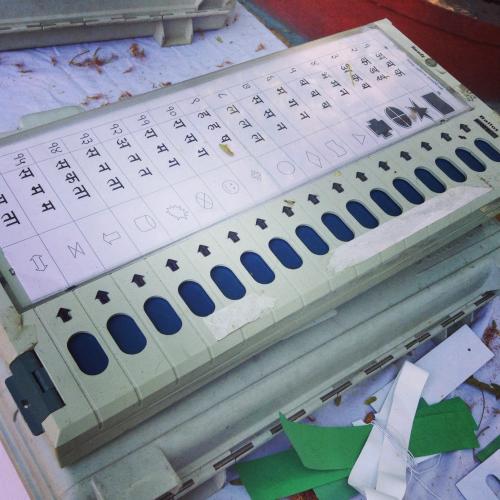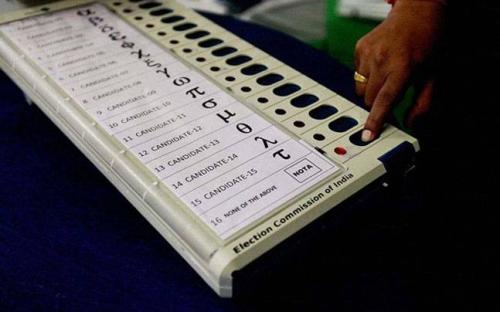Innovations in technology have rapidly transformed democracies in the last two decades. One area where digital technology’s relevance and impact has often been debated is the use of Electronic Voting Machines (EVMs) in the choice of political leaders. Compared to a pencil-and-paper system, technology has tremendous potential to empower citizens, amplify their voices, and allow citizens to hold governments accountable.
In electoral democracies, free and fair elections convert voters’ preferences into a political mandate that forms the basis for policymaking. More precise and efficient voting procedures boost the strength of democratic institutions. The literature on democracy and development suggests that enhanced representation—giving the marginalized and vulnerable sections of the society a voice—leads to greater development.
The efficiency and quick turnaround time observed with EVMs become particularly crucial when they are used for larger populations. The scale of the recently held general election in India bears testimony to how EVM technology addresses electoral fraud and simplify the electoral procedure. The election witnessed a historic 67 percent voter turnout from nearly 900 million registered voters across 542 parliamentary constituencies. For a democracy of this size with a complex multi-party system, electoral fraud is naturally a leading concern. But the use of EVMs in India’s electoral procedure over the years has given its voters confidence that their vote makes a meaningful difference to election results and democratic governance.
EVMs were introduced in India on an experimental basis in 1998 in a select few constituencies in state assembly elections. The objective of using EVM technology in India was to strengthen the electoral processes and to reduce the costs of conducting elections. Upon preliminary success, the technology was then rolled out in a phased manner for subsequent assembly elections. EVMs replaced paper ballots throughout the country from 2001 onwards.
Our research study [1] published in 2017 measured the impact of using EVMs on electoral fraud, democracy, and development in India. The phased roll-out of the EVMs in state assembly elections in India and the timing of the assembly elections (the Constitution of India mandates that state elections be held every five years) allowed us to determine the causal impact of EVMs on electoral fraud and democracy. Using a novel identification strategy—intra- and interstate variations—for state assembly election results from 1976 to 2007 and post-poll survey data, the study provides strong evidence that the introduction of EVMs led to (i) a significant decline in electoral fraud, (ii) strengthening the weaker and vulnerable sections of the society, and (iii) a more competitive electoral process.
On electoral fraud
Under the paper ballot system, polling booths would often be captured and ballot boxes would be stuffed, resulting in an unusually high voter turnout. EVMs helped tackle this risk by incorporating an important feature—registering only five votes per minute. Committing electoral fraud would require capturing polling booths for longer periods. Further, the study also finds a significant decline in electoral fraud in politically sensitive states where electoral rigging led to frequent re-polls.
On representativeness
The ability of vulnerable citizens (illiterates, women, scheduled castes and tribes, handicapped, and the elderly) to cast their votes is hampered under the paper ballot system. In a country where a significant portion of the marginalized population is illiterate or uneducated, interpretation of paper ballot signatures or thumb impressions to determine the validity of votes is left at the discretion of election officers. The votes of vulnerable groups are virtually eliminated due to being error-ridden. EVM technology ensures that these groups not only participate in elections, but that their votes also properly counted.
The success of the EVMs in India warranted a comprehensive audit mechanism to verify the votes cast. In 2013, the Election Commission of India formally incorporated Voter Verified Paper Audit Trail (VVPAT) machines in the electoral systems. The VVPAT—leaving behind a paper trail of the vote cast—acts as an additional layer of verifiability and assurance in the electoral process. A paper record ensures that the vote has indeed gone to the intended candidate and is recorded as such. It then becomes a part of the audit trail. As per the Supreme Court of India’s ruling in 2019, a random matching of VVPAT slips with EVMs took place in five polling booths per assembly segment. Of the 1.73 million VVPATs deployed, slips from 20,625 VVPATs were physically counted. The physical audit did not find a single case of a mismatch between the VVPAT slip and the EVM count.
The world is radically moving towards a governance system where every individual has a voice and all are held accountable. There is simply no shying away from the technology that can be harnessed to achieve a government “of the people, for the people, and by the people”. Having successfully used EVMs over the years at such a large scale with little to no error, India is now moving towards becoming a ‘techno-democracy’. The reform of its electoral system has been truly innovative and revolutionary in reshaping governance that can be replicated in other democracies.
[1] Debnath, S., Kapoor, M., & Ravi, S. (2017). The impact of electronic voting machines on electoral frauds, democracy, and development. Democracy, and Development (March 16, 2017).
See also Kapoor, Mudit, et al. “Why EVMs Are Win-Win.” The Indian Express, 22 Mar. 2017.
The Brookings Institution is committed to quality, independence, and impact.
We are supported by a diverse array of funders. In line with our values and policies, each Brookings publication represents the sole views of its author(s).












Commentary
How electronic voting machines have improved India’s democracy
December 6, 2019